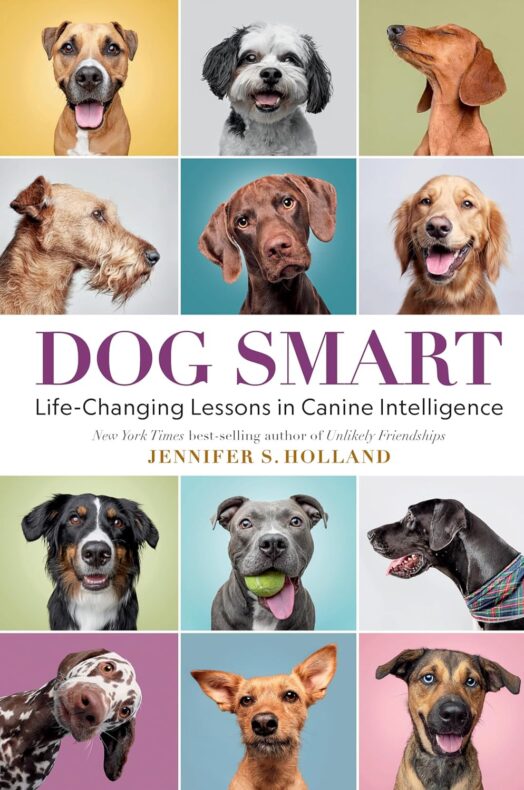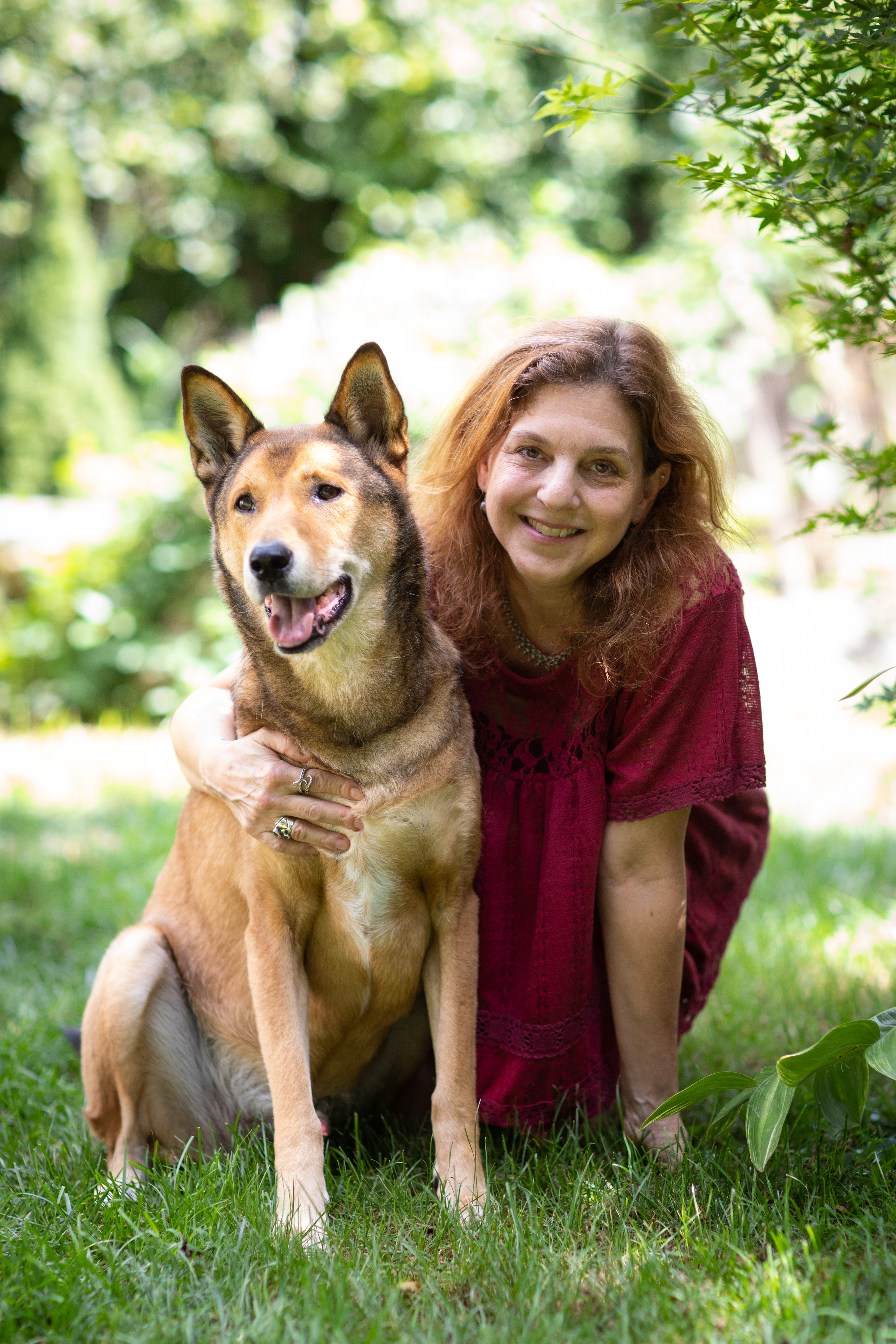I first met Our Jenny in 2010 (I think?), when I walked into her office at National Geographic to buy a lizard. It’s a cute story; we’ll tell it some other time. For now, all you need to know is that the reptile sale turned into a friendship, and then a collaboration, as I helped Jenny with research for some of the books in her bestselling Unlikely Friendships series. Her latest book, Dog Smart: Life-Changing Lessons in Canine Intelligence, is out this month, and I can’t wait for you to hear about it.

KH: So, the Unlikely Friendships books were structured around anecdotes and photographs, but Dog Smart takes a sciency-er (to use the technical term) approach. What was it like making that shift?
JH: It’s hard! Really hard. My brain works in little chunks. I originally started out [at National Geographic] writing photo legends for the magazine, and my other books were made of short stories I could work on one at a time without thinking about the narrative thread or how to tie it all together. This required a lot more brainpower, and more discipline. It was a really good challenge. It forced me to work differently and to keep asking myself, “Why am I writing this part? What is it really about? And how does it fit in the bigger picture?”
KH: How did you organize your research?
JH: I might just have the biggest Scrivener file on earth. That was one of the big challenges for me, just keeping things straight. Once I had the big ideas down, I could make folders, pulling in the relevant bits and pieces and interviews, but a lot of things spanned different subjects. There was a lot of rethinking and reorganizing. I’m sure there are things that got lost along the way, but the materials that made it in were pretty substantial.
KH: Do you know how many interviews you did?
JH: Definitely over 100.
KH: Wow.
JH: I’m not sure how many voices actually ended up in the book. As [the research process] went on, I tried to rein myself in a little bit, but in the beginning it was just anybody and everybody that was even a little bit relevant.
KH: Do you have a preference between reporting and writing?
JH: I love being in the field, actually going out with someone and doing something. I think my best writing comes from those scenes. And I enjoy writing, once I’m on a roll. But there are times when it’s just painful.
KH: What was your favorite experience out in the field?
JH: Oof. Difficult.
KH: I know. That’s a mean question.
JH: One of my favorites was spending time with this lovely woman named Suzi Goodhope. Her dogs are trained for human remains seeking. I went down to visit her in Florida, and we went to this area where there are old Black cemeteries. They’re trying to draw edges of these old cemeteries that didn’t have borders and weren’t shown on maps. It was just fantastic. I loved her, and Fletch, her dog, was awesome. It was just so amazing to see an animal that can smell something that’s a hundred years old or more that’s been buried in a landscape that’s been untouched all these years.
KH: I don’t want to give away too much of the book, but how do dogs get trained to do that?
JH: You can train a dog to smell pretty much anything that has a smell. We don’t have to be able to smell it. There are studies where they’re looking at how little of something has to be present for a dog to smell it, and it can be in the [parts per] trillions, and maybe even the quadrillions. I don’t even know how to wrap my head around what that even means. So they train these dogs on old bones, and train them not to mistake animal bones for human bones. Suzi would take home a dead squirrel or animal bones for her dogs to work with to remind them, Not this. It’s remarkable. With the right positive reinforcement and the right people doing it, dogs can be trained to find pretty much anything.
KH: That’s mind-boggling.
JH: Yeah, and they love it. That’s the thing, too—all the working dogs I saw in the field love what they’re doing. They’re not being forced to do anything. This is exciting for them. And the people who work with them will make sure that they get rewarded even if they’re not finding something. They’ll even fake it, so the dog gets a win and feels like it did its job.

KH: That’s wonderful. I feel like we’re already heading into this territory, but: was there something you wanted to include that you had to cut that haunts you?
JH: I wouldn’t say it haunts me, but there was a time early on when I thought I was going ot do a whole section on lost dogs. And by lost, I mean emotionally lost dogs, where human have not done right by these animals. These dogs end up in really bad situations, and often get euthanized. I wanted to write about what happens when the emotional connection gets lost, and whether you can regain that with dogs. I was talking with some people about how they rehabilitate dogs that have been through such traumatic situations. Ultimately, it didn’t quite fit the flavor and tone of the book. But it is something I’m interested in and would like to look at more.
KH: Another difficult question: what were your favorite parts of the book to write?
JH: I like writing personal stuff. There’s a dog named Odin that appears in, I think, five different scenes, who I learned from along the way. I used him as a narrative thread, beginning with “what does it mean to approach a dog you don’t know?” and then “how do you learn to read a dog?” and “how do you make the right moves to make sure that dog trusts you?” I won’t give away everything about my relationship with Odin, but I loved writing that stuff. There were some personal moments in there that were really important to me. I like writing from the heart (and not having to fact-check).
KH: Have you thought about doing a personal book?
JH: I have, yeah. That is definitely something I’d like to do. [My husband] keeps telling me, “You have so many stories from the field,” but my memory is so fragmented that it would have to be a book of fragments. Which could be cool. I have also thought about writing about watching my dad decline. It felt more urgent when I was going through it, and a lot of people have written that story, so maybe that doesn’t need a whole book. But something personal is definitely in the future.
KH: Who is the ideal Dog Smart reader, and what do you want them to take away from it?
JH: My audience tends to be animal lovers. My hope is that even the people who think they know dogs, and know how to relate to dogs, will find, Wow, there’s so much more to it than I realized. Because that’s what I went through. I went into this thinking I already knew all this stuff. I’ve had dogs all my life. But there’s so much more nuance to it. Writing this book definitely changed how I treat my dogs. Like, my dog likes to sniff, and I’m always in a hurry. And now I will pause and say, If he wants to go over there and sniff that nasty whatever-that-is, let him do it. If we let them be dogs, we’re letting them tap into their natural intelligence. I owe my dogs the opportunity to be themselves and do dog things.
JH: So I’m hopeful that even the deepest animal lovers will learn something and maybe even change a little something about how they think about their dogs and other animals. Because as much as this is about dogs, dogs are not the smartest animals out there (depending on how you define intelligence). They’re just the ones that were smart enough to become our best friends.
*
This interview has been edited for clarity and length.
Image credits: National Geographic Books (book cover), Laura Toraldo (author photo).
We have two rough collies (“Lassie dogs”). Hailey, a tricolor, is 11 and Peregrin, a sable merle, is 7. We live in Humboldt County, CA on an acre in a nice rural residential neighborhood not far north of Arcata. Part of it is garden and part has been left to revert to its natural condition of trees, including redwoods, a variety of native plants, etc.. We also have a large pond which attracts herons, egrets and a pair of mallards who stop in for a bit in the early spring.
Both collies are quite intelligent as is the breed in general. The “Lassie thing” is real. They keep an eye on everything, go to the mailbox with me, let us know if there’s something going on on the private road a number of us live on. They have a distinctive bark with I think of as the “Come quick Timmy’s fallen down the well!” bark.
If you do decide to do a book on dog intelligence, and I really hope you do, you need to include rough collies IMHO.
FWIW I’m a longtime fine artist who specializes in animals.